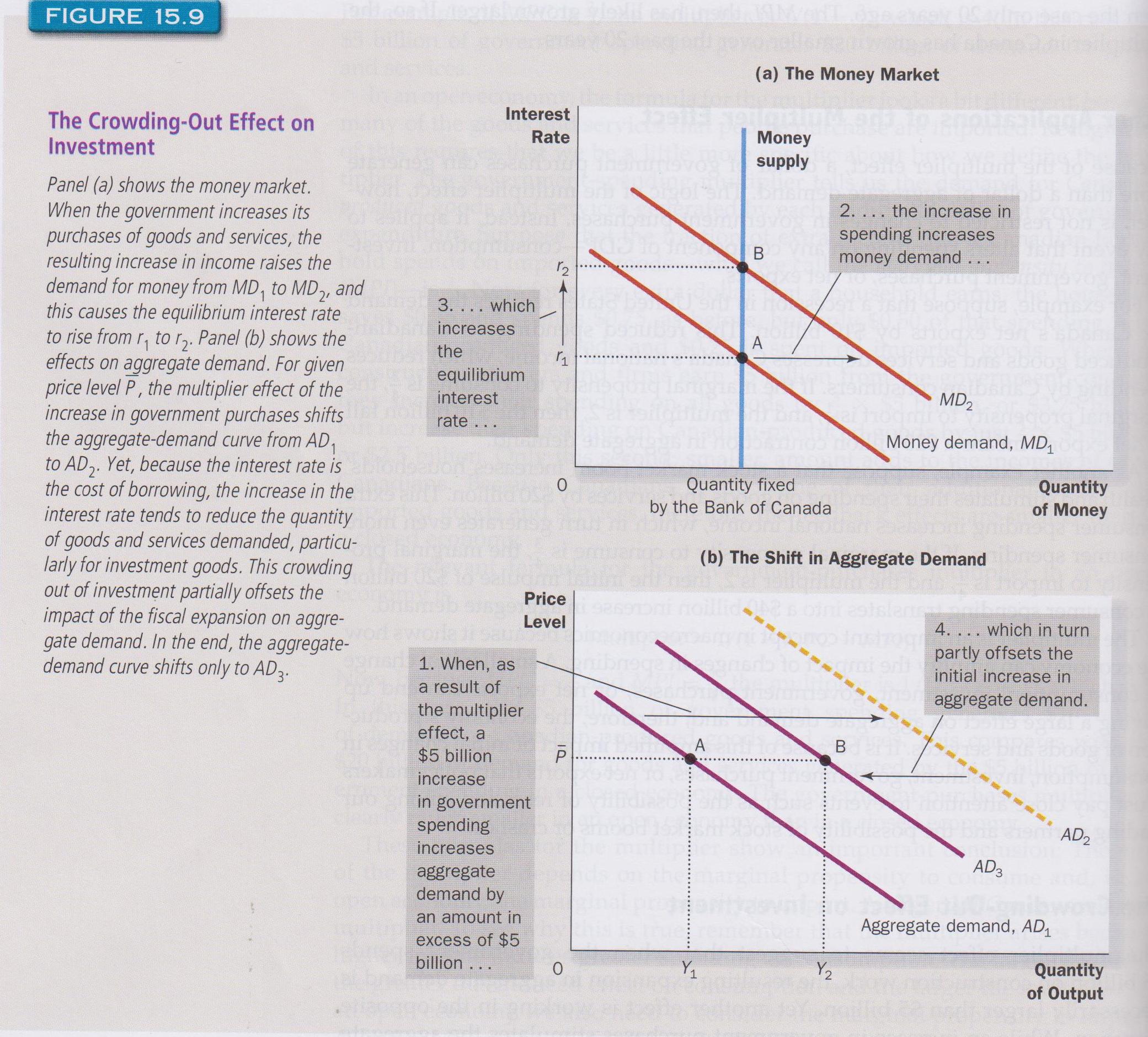|
1. Money, Interest and Aggregate Demand
(MKM C15/379-82;
401-3; 410-13: 356-59; 376-77; 384-87;
366-368; C16/395-396; 340-342;
371-372)
- how fiscal and monetary policy affect real GDP and the price level
a) Equilibrium Expenditure & Interest Rate
- will show that equilibrium expenditure depends on investment which in turn
depends on interest rate; therefore equilibrium expenditure and real GDP depend
on interest rate
i- Money Market
- Let us assume that MS determined by central bank, i.e. for purposes of this
analysis MS is fixed or 'given' and therefore 'inelastic'
- we know that demand for money (MD) depends on level of real GDP and that any
level of real GDP MD will be downward sloping varying according to the 'price of
money', i.e. the interest rate
- therefore for any given level of real GDP (P&B
Fig. 29.1 a) there will be an equilibrium point
for MD and MS defined by the fixed level of MS and a specific interest rate
ii- Investment & Interest Rate
- we know that investment is inversely related to the interest rate, i.e.
investment will increase as the price of money falls
- therefore given the equilibrium price of money determined in the money market
there will be a specific level of investment
iii- Equilibrium Expenditure
- investment is part of 'autonomous expenditure' including government spending
and exports
- assuming given levels for government spending and exports, total autonomous
expenditure will be measured by a specific intersection point of the AE curve
and the x-axis depending on the level of investment determined by the interest
rate which in turn is determined by equilibrium in the money market
- induced expenditure (consumption less imports) increases from this point of
intersection at a slope reflecting, primarily, the marginal propensity to
consume (adjusted for the impact of the tax rate and marginal propensity to
import)
(R&L
Fig. 22-3)
2. Fiscal Policy & Aggregate Demand
- assume government pursues expansionary fiscal policy, i.e. will increase G (P&B
Fig. 29.2)
a) First Round
-
increase in G shifts AD curve to right
-
higher price level, higher real GDP
b) Second Round
-
increase in real GDP increases demand for money MD1 to MD 2
-
increased demand for money raises interest rate decreasing I causing AD
to shift to left
-
but upward movement along new AD curve reflecting rising price
level to attain new equilibrium which decreases real supply of money
which increases interest rate further (P&B Fig. 29.3)
c) Other Fiscal Policies
- increase in G is only one fiscal policy tool available to government.
Another is a change
in transfer payments but its impact will be different because of differential effect on MPC,
i.e. lower income households have higher MPC therefore it will change slope of
AE
- Government can also change tax policy, e.g. a change marginal tax rates will similarly change slope of AE by
its impact on MPC
- All these changes will affect interest rate and hence investment and hence AE
and AD.
d) Crowding Out and Crowding In ( C8 178;
C 16 389-392; C8
163; C 16
365-369
- Government borrowing on the financial markets will reduce Investment (I)
through 'crowding out'. Thus government borrowing increases money demand
raising interest rates which causes investment to fall (R&L 13th Ed
Fig. 32.6; MKM Fig. 15.9).
 - This may be partial or complete but usually partial - This may be partial or complete but usually partial
- However, if increase in G is spent on improvement in infrastructure this can reduce costs of
doing business and therefore increase I; or, if the increase in G increases the
expectation of economic growth I may increase even if interest rates go up
because of
business expectation of improved opportunities;
- Similarly, a decrease in business may also increase I.
The impact of improved infrastructure and reduce business costs as well as
decrease in business taxes can lead to ''crowding
in", i.e., increased I
- All things being equal crowding in less likely.
e) Exchange Rate and International Crowding Out
- An increase in interest rate tends to increase value of a currency on world markets
as foreign funds flow to higher rates.
- There are various effects of an appreciating currency: (i) decreases X reducing
autonomous expenditure; (ii) increase in imports decreasing induced expenditures (C-M);
(iii) increase in foreign investment increasing I raising autonomous expenditure.
3. Monetary Policy and Aggregate Demand
- Let us assume the central bank decides to pursue expansionary monetary policy.
The effect will depend on the elasticity of the investment function. The
more elastic, the greater the effect; the more inelastic, the less the effect
(R&L 13 Ed
Fig. 28-10).
a) First Round
-
An increase in the MS shifts the curve to right decreasing interest rate and increasing I.
This leads to an increase I shifting AD curve to right increasing real GDP and price level (MBB not displayed; P&B
Fig. 29.5).
b) Second Round
-
The increase in real GDP, however, increases MD shifting the curve up to right.
The upward movement of AD curve causes a rising price
level (to attain new equilibrium) which decreases real supply of money
which increases interest rate further (P&B
Fig. 29.6).
|
